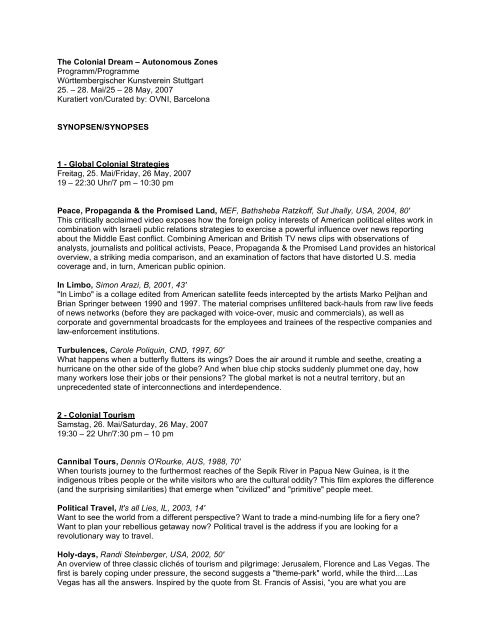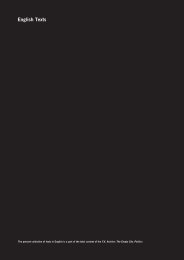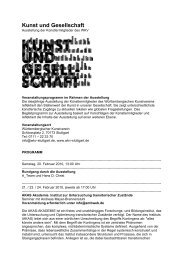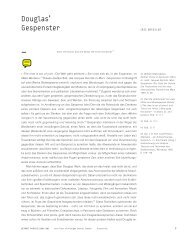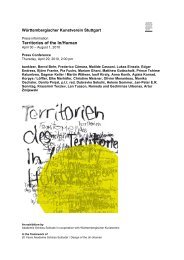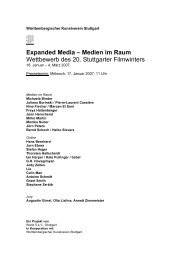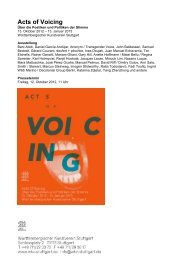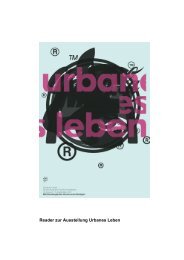The Colonial Dream – Autonomous Zones Programm/Programme ...
The Colonial Dream – Autonomous Zones Programm/Programme ...
The Colonial Dream – Autonomous Zones Programm/Programme ...
Create successful ePaper yourself
Turn your PDF publications into a flip-book with our unique Google optimized e-Paper software.
<strong>The</strong> <strong>Colonial</strong> <strong>Dream</strong> – <strong>Autonomous</strong> <strong>Zones</strong><br />
<strong>Programm</strong>/<strong>Programm</strong>e<br />
Württembergischer Kunstverein Stuttgart<br />
25. – 28. Mai/25 – 28 May, 2007<br />
Kuratiert von/Curated by: OVNI, Barcelona<br />
SYNOPSEN/SYNOPSES<br />
1 - Global <strong>Colonial</strong> Strategies<br />
Freitag, 25. Mai/Friday, 26 May, 2007<br />
19 – 22:30 Uhr/7 pm – 10:30 pm<br />
Peace, Propaganda & the Promised Land, MEF, Bathsheba Ratzkoff, Sut Jhally, USA, 2004, 80'<br />
This critically acclaimed video exposes how the foreign policy interests of American political elites work in<br />
combination with Israeli public relations strategies to exercise a powerful influence over news reporting<br />
about the Middle East conflict. Combining American and British TV news clips with observations of<br />
analysts, journalists and political activists, Peace, Propaganda & the Promised Land provides an historical<br />
overview, a striking media comparison, and an examination of factors that have distorted U.S. media<br />
coverage and, in turn, American public opinion.<br />
In Limbo, Simon Arazi, B, 2001, 43'<br />
"In Limbo" is a collage edited from American satellite feeds intercepted by the artists Marko Peljhan and<br />
Brian Springer between 1990 and 1997. <strong>The</strong> material comprises unfiltered back-hauls from raw live feeds<br />
of news networks (before they are packaged with voice-over, music and commercials), as well as<br />
corporate and governmental broadcasts for the employees and trainees of the respective companies and<br />
law-enforcement institutions.<br />
Turbulences, Carole Poliquin, CND, 1997, 60'<br />
What happens when a butterfly flutters its wings? Does the air around it rumble and seethe, creating a<br />
hurricane on the other side of the globe? And when blue chip stocks suddenly plummet one day, how<br />
many workers lose their jobs or their pensions? <strong>The</strong> global market is not a neutral territory, but an<br />
unprecedented state of interconnections and interdependence.<br />
2 - <strong>Colonial</strong> Tourism<br />
Samstag, 26. Mai/Saturday, 26 May, 2007<br />
19:30 – 22 Uhr/7:30 pm – 10 pm<br />
Cannibal Tours, Dennis O'Rourke, AUS, 1988, 70'<br />
When tourists journey to the furthermost reaches of the Sepik River in Papua New Guinea, is it the<br />
indigenous tribes people or the white visitors who are the cultural oddity? This film explores the difference<br />
(and the surprising similarities) that emerge when "civilized" and "primitive" people meet.<br />
Political Travel, It's all Lies, IL, 2003, 14'<br />
Want to see the world from a different perspective? Want to trade a mind-numbing life for a fiery one?<br />
Want to plan your rebellious getaway now? Political travel is the address if you are looking for a<br />
revolutionary way to travel.<br />
Holy-days, Randi Steinberger, USA, 2002, 50'<br />
An overview of three classic clichés of tourism and pilgrimage: Jerusalem, Florence and Las Vegas. <strong>The</strong><br />
first is barely coping under pressure, the second suggests a "theme-park" world, while the third....Las<br />
Vegas has all the answers. Inspired by the quote from St. Francis of Assisi, “you are what you are
seeking”, award-winning filmmaker Randi Steinberger set out to document her observations and those of<br />
the contemporary traveler. Shot entirely in the three mythic cities of Jerusalem, Florence and Las Vegas,<br />
tourists, guides and experts reveal a subtle contradiction between the modern pilgrims anticipated<br />
expectations and their actual experiences. What we seek can be as profound as a religious epiphany, as<br />
superficial as a successful shopping spree, or as life changing as winning the big jackpot. Throughout we<br />
are subtly reminded that if we journey to seek change, we should remember to pack our sense of humor.<br />
3 - <strong>The</strong> hidden city: Barcelona Real State <strong>Colonial</strong>ism & <strong>Autonomous</strong> <strong>Zones</strong><br />
Sonntag, 27. Mai/Sunday 27 May, 2007<br />
15 – 18:30 Uhr/3 pm – 6:30 pm<br />
Bassi Bus, Conservas, Interven TV, E, 2006, 24'<br />
In July 2005, the comic Leo Bassi took his Bassibus services to the city of Barcelona. In this politicaltourism<br />
trip we came up close to the very heart of speculation and real estate violence, and met some of<br />
its main protagonists. Step right in and see... This tour has been possible thanks to the participation of<br />
people and groups who have been fighting for years to defend the territory and the dignity and rights of<br />
the people who live in it.<br />
El forat, Jose Maria V. Peña , E, 2004, 75'<br />
Between 2000 and 2003, PROCIVESA, the property development company that is restructuring various<br />
areas in the old part of the city, expropriated various housing blocks in Barcelona’s La Ribera<br />
neighbourhood at a low price. And then demolished them. Local residents named the new empty space<br />
that remained where their houses used to be the “Forat de la Vergonya” (the Hole of Shame), as a way of<br />
denouncing a situation that they considered degrading for a number of reasons: the public authorities?<br />
abandonment of an area that was already problematic, the interminable construction work, the loss of<br />
rights of people relocated to new apartments, etc.<br />
C/ GUARDIA 14 BIS 08001 BCN, Juan Fernando Lopez, E, 2005, 30'<br />
An old building in Barcelona's historic Barrio Chino is the setting for this documentary. Real estate<br />
“mobbing” and the urban rehabilitation of the old city are the narrative thread, the economic machines that<br />
drive real estate speculation. <strong>The</strong>y take over the neighbourhood, burying its history and memory.<br />
A Tornallom, Enric Peris, Videohackers, E, 2005, 48'<br />
A Tornallom is a documentary about the struggle to defend de irrigated area used for cultivation known as<br />
La Huerta de Valencia. It shows us images and testimonies of the events that occurred between<br />
September 2002 and March 2003, when more than 200 residents of La Punta (in the Huerta area) were<br />
evicted from their houses. <strong>The</strong> villages were demolished and the fields bulldozed to make room for the<br />
ZAL (logistics activities zone) of the Port of Valencia, which is planned to take up around 600,000 square<br />
meters, most of the area of La Huerta. “A Tornallom", is what the agricultural workers of La Huerta call the<br />
way they swap work amongst themselves. For heavy agricultural tasks workers usually help each other,<br />
pooling their efforts to do the work on one person’s field and going on to another the next day until all the<br />
work is done. That's working ‘a tornallom’: work in exchange for work.
4 - <strong>Colonial</strong> Borders<br />
Sonntag, 27. Mai/Sunday 27 May, 2007<br />
19:30 – 21 Uhr/7:30 pm – 9 pm<br />
Africa 1947 Highlights, News & Flashes, 1947, 4’<br />
Queen Elizabeth pays homage to Cecil Rhodes on her tour to Africa. Tribes pay tribute to Queen<br />
Elizabeth.<br />
Natives, Jesse Lerner, Scott Sterling, MEX/USA, 1991, 25'<br />
<strong>The</strong> U.S.-Mexican Border is the site of a disturbing increase in violence and racial intolerance. Along the<br />
border there are now a number of 'nativist' groups that have organized with the stated purpose of ending<br />
undocumented immigration. "Natives" follows the individuals involved in San Diego's anti-immigration<br />
movement. Relying principally on a direct cinema style and an eye for the absurd, the film critiques the<br />
nativist position by contrasting their professed love of country with their racist and anti-democratic<br />
attitudes. Though the US has long maintained a reputation as a haven for immigrants, there is<br />
nonetheless a strong tradition of nativism and xenophobia. In the decade of the 1990s, there was a new<br />
surge of anti-immigrant sentiment. This film examines the nativist discourse along the US-Mexico border,<br />
a place that brings issues of nationalism and intolerance into sharp focus.<br />
La Forêt, Colectivo Frontera Sur, E, 2005, 43'<br />
In Benyounes forest, “la foret” as they called their habitants, was the last stage of a long trip for thousands<br />
of people coming from Sub-Saharan Africa. Close to the fence that divides Ceuta (Spain) from Morocco,<br />
they establish in a variable time, before flank the last obstacle in they way to Europe, looking for a better<br />
life. Sometimes running away from wars, politics persecutions, hunger or a precarious economy situation.<br />
Lots of times of all of this. In years, the migrants pass across this forest and after some weeks or months<br />
they manage to arrive to Ceuta. In finals of 2004, European union start agreements of subcontract<br />
Morocco in the control of the Spanish – Moroccan border. <strong>The</strong> habitants of the forest, started to feel the<br />
effects of this agreements: the increase of illegal devolutions, the abuses from the civil police, they install<br />
police controls near the forest, they forbid the access to current water, military attacks to the camps in with<br />
they made mass arrests and rapes as a war weapon. <strong>The</strong> border it’s close. Systematic violation of human<br />
rights, financed with the tax of the democratic European Union citizens. <strong>The</strong> migrants organize<br />
themselves in spaces like this and construct spaces; support nets in Moroccan territory, confronting and<br />
resisting this way the European politics. In the forest of Benyounes, they organized themselves from origin<br />
communities. In February of 2005, decided between all the community’s, record this video, to made visible<br />
their situation, in with they report the systematic violation of their human rights, the absolutely<br />
abandonment from the NGO’s, Associations an Human Rights Institutions, an they demand their citizens<br />
condition and they require their rights as human beings.<br />
On Translation, Fear, Antoni Muntadas, MEX/USA, 2005, 30'<br />
On Translation: Fear/Miedo is a televised intervention based on a video production that weaves together<br />
interviews with people who experience the tensions of the border zone on a daily basis, archival televised<br />
footage that makes reference to the idea of fear on the border between Mexico and the United States, and<br />
other documentary and journalistic material. <strong>The</strong> video aims to reveal how fear is a translated emotion,<br />
revealing itself in differing ways on both sides of the border as a cultural/sociological construction based<br />
on politics and economics. On Translation: Fear/Miedo was broadcast between August and November<br />
2005 in four distinct locations that connect the centres of power/decision-making with the places where<br />
these policies are evident everyday: Tijuana, San Diego, Mexico City and Washington, DC.
5 - <strong>Colonial</strong> <strong>Dream</strong> 1<br />
Montag, 28. Mai/Monday, 28 May 2007<br />
15 – 18 Uhr/3 pm – 6 pm<br />
Mother Dao – <strong>The</strong> Turtlelike, Vincent Monnikendam, NL, 1995, 90'<br />
Unfolding without narration, Mother Dao, the Turtlelike is a spare and elegant film constructed entirely<br />
from archival footage... Luminous nitrate images are set against a simple soundtrack of birdcalls, bells and<br />
murmuring voices, punctuated occasionally by native poems and songs. <strong>The</strong> film's careful construction<br />
reveals the face of systematic colonization and the effect of economic expansion on a culture.<br />
Oriente Medio, Destacados de 1947, News & Flashes, USA, 1947, 12'<br />
<strong>The</strong> UN votes to partition Palestine. Riots in the face of the partition of Palestine. <strong>The</strong> Suez Canal is<br />
handed over to Egypt after 72 years of Brittish control. Incidents on the Israel-Egypt border. <strong>The</strong> Egyptian<br />
Crisis. Israel withdraws from Sinai. For decades, Movietone was one of the major international news<br />
broadcasting agencies. It shaped the collectve imaginary, created by the mass media, of a large crosssection<br />
of Americans and Europeans.<br />
Je vous ai compris, Jean Pierre Gambarotta, no-zone, 2006, 15'<br />
1958 General De Gaulle pronunces – in a very convulse and tragic moment for an Argelia under rigorous<br />
represion and torture – its famous and demagogic “Je vous ai Compris” (I understand you). A reading on<br />
several audiovisual documents of that time gives to us an opposite meaning to that sentence. “Je vous ai<br />
Compris” now means and show us the real sense of the civilizational work of the western powers. Today<br />
so enthusiaticly renovated.<br />
Una cruz en la selva: Guinea, Jean Pierre Gambarotta, no-zone, 2006, 31'<br />
An Archives research and edit on several audiovisual documents from various sources dealing with the<br />
old Spanish colony of Equatorial Guinea, most of it created for information and educational purposes.<br />
Images that illustrate the colonial obsessions of the times: the idyllic image of Spain’s civilizing task,<br />
nostalgia for imperial times, the sadistic element in the hunt for wild animals, the work of Christianisation,<br />
the militarization of a layer of the population in order to ensure the existence of “loyal natives”, the<br />
perpetuation of the African stereotype.<br />
6 - <strong>Colonial</strong> <strong>Dream</strong><br />
Montag, 28. Mai/Monday, 28 May 2007<br />
20 – 21:30 Uhr/8 pm – 9:30 pm<br />
Afrique 50, Renè Vautier, F, 1950, 25'<br />
An anticolonial film about colonial repression on the Ivory coast. A virulent attack on the French colonial<br />
system after the second world war that has been banned in France for half a century.<br />
Les Maîtres Fous, Jean Rouch, France, 1954, 35'<br />
Les Maitres Foux is about the ceremony of a religious sect, the Hauka, which was widespread in West<br />
Africa from the 1920s to the 1950s. Hauka participants were usually rural migrants from Niger who came<br />
to cities such as Accra in Ghana (then Gold Coast), where they found work as labourers in the city's<br />
lumber yards, as stevedores at the docks, or in the mines. <strong>The</strong>re were at least 30,000 practicing Hauka in<br />
Accra in 1954 when Jean Rouch was asked by a small group to film their annual ceremony During this<br />
ritual, which took place on a farm a few hours from the city, the Hauka entered trance and were<br />
possessed by various spirits associated with the Western colonial powers: the governor general, the<br />
engineer, the doctor's wife, the wicked major, the corporal of the guard.


